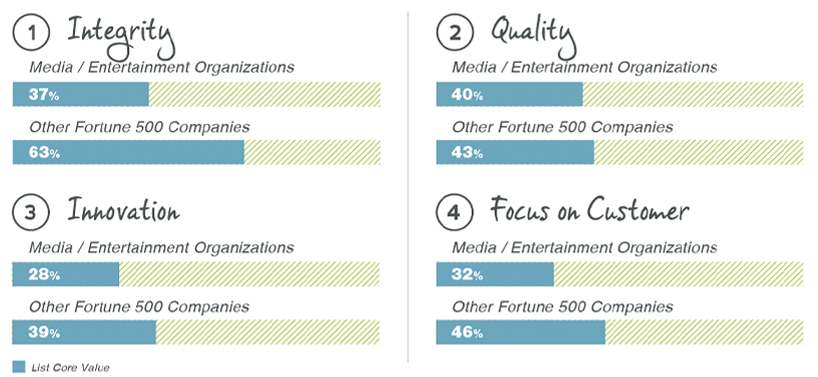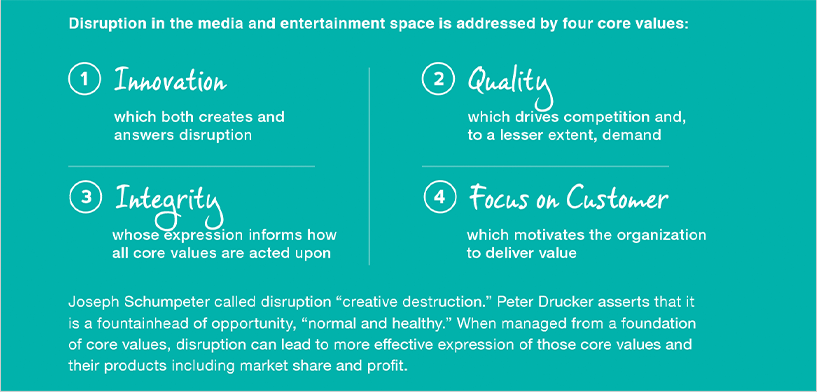Report
Four hidden levers media organizations can use to get ahead of disruptions

New research by Eagle Hill Consulting reveals a factor that makes disruption even more challenging for media and entertainment organizations. These organizations are much less likely than other companies to identify “integrity or morals” as a core value. This matters because such a lack of emphasis poses a structural challenge: the foundation for addressing disruption in this unique space is built on four core values – integrity, innovation, quality, and focus on the customer – acted upon at all levels.
Fortune 500 Media and Entertainment Organizations are less likely to include “Integrity or Morals” in Core Values:

Source: Eagle Hill Consulting Fortune 500 Core Values Analysis
There’s never been so much deep disruption
Media and entertainment organizations face an environment that connects organizations in ways that are even more deep-seated than before. Tech companies have invested trillions in platforms and need content to make them more valuable to consumers. Content providers have no access to consumers without vigorous tech platforms. Technology is changing at an accelerating pace, creating unpredictable disruption across all levels of an operation. Compare current challenges to previous disruptions in the industry. The short history of television is one of minimal technical investment relative to current levels and relative to other spending. Even the disruption from MVPDs was ameliorated by its slow and incremental spread.
Prior to the internet, the financial barriers to entry into broadcasting were beyond the capacity of most aspirants. Broadcasters were further insulated from new competition by regulation and the built-in capacity limits of over-the-air transmission. Today, literally anyone with a computer (or a mobile device) can create content and distribute it with no investment beyond their time. Telephone, cable, and satellite companies, having already built the costly infrastructure, have been emboldened to make the leap to vertically integrate into content creation, where low-cost speculation can pay off exponentially.
Even consumers are getting in on it
Consider also disruption on the consumer side. According to a recent report from USC Annenberg’s Center for the Digital Future, time online has more than doubled in less than twenty years. Today, adults spend nearly one 24-hour day per week in front of a computer or phone screen. 2018 will be the first year people around the world spend more time online than watching TV, this from the measurement company Zenith. Limelight Networks reports that after social media, viewing video is the most popular online activity.
Changes are not consistent across demographics. For instance, Eagle Hill research reveals that viewers identifying as non-white are twice as likely as white viewers to prioritize convenience of viewing over viewing quality. This research also shows that members of the rising Millennial generation are four times more likely than those 55 and older to prioritize convenience over viewing quality. Millennials are also 20 times more likely than those 55 and older to watch TV on the go.
Finally, consider just one result of all this increased demand. Estimates for Netflix’s content budget are as high as $13 billion – about two-thirds more than earlier reporting this year of $8 billion – up from $6 billion in 2017.
There’s no beating disruption without key core values

Core values = the master enabler
Taken together, the four core values are a “master enabler” of change that meets disruption. Innovation is expressed in content, management, and technology. It is informed by a commitment to quality in an effort to determine and meet the needs of customers. It is driven by corporate integrity that builds pride in the value of the product or service, the nature of the workplace, the success of the enterprise, and the larger contribution to the community, the industry, and the world.
Stability at the root enables growth and change at the level of the department, team, and job. This may take the form of accelerated professional development opportunities, focused interaction with management, education, and explicit encouragement.
The challenge then is to take practical action on these values. Here’s how:

How-To #1:
Showcase “our common cause”
Organizations reinforce the four core values internally by reinforcing investment in a common purpose. This can be a disruptive act in itself, as it is unrelated to typical headcount metrics. Employees of companies such as Disney are united as curators of the Disney legacy; this as opposed to a media and entertainment organization that produces product primarily to fit commercial specifications. Organizations so united have a unique opportunity because they value their work as craft, entertainment, or art, and take pride in its emotional and cultural resonance.
This kind of value is unmeasurable but tangible. It appears as pride in its wide impact; as personal validation; as loyalty toward preserving and extending a strong reputation or brand; as satisfaction with mastery; and as the anticipatory urge to do more. It all flows from a top-down commitment to a greater good, the provision of true benefit to society, culture, and individuals.

How-To #2:
Really learn about the other teams
Typically, media and entertainment organizations are comprised of three teams: creative, technical, and business. A failure of each to understand the roles of the others is a missed opportunity to leverage the power of what they have in common.
Each team often understands the others mostly in terms of limits, such as creatives knowing that they must work within the limits of the technology their organization can access. A more powerful alignment begins with awareness of function. For instance, business people may become part of a product feedback loop with creatives if each creative learns how and why business handles a product or service the way they do, and if business understands how that output is created and why it takes the form it does.
In this way, disruption is again answered by disruption. Innovation is woven into daily work. And integrity is expressed not as an assertion of intention but as a practical expression of respect for and utility of difference. The result: action to build innovation and integrity improves the environment inside the organization as well as quality and focus on the customer.

How-To #3:
Swap “jobs” for “roles“
The jobs of tomorrow will be unlike the jobs of today. To anticipate the change, shift responsibility away from task-based approaches into roles centered on objectives. To change management in this way, employers need to trust their employees, but there is reason to do so. Employees charged with taking action to realize corporate goals in the spirit of corporate core values are motivated to rise to the occasion by their own core values. This can become an engine for more productive interaction among employees and more organic communication between employees and management.

